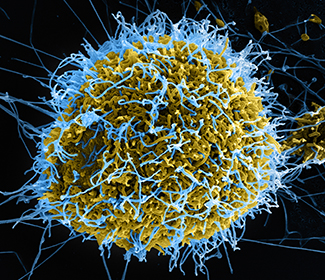Fogarty’s response to Ebola: Where are we now?
July / August 2022 | Volume 21 Number 4
 Photo courtesy of NIAIDThe research community has learned much more about Ebola since 2014. This colorized micrograph shows Ebola virus particles (blue) budding from an infected cell (yellow-green).
Photo courtesy of NIAIDThe research community has learned much more about Ebola since 2014. This colorized micrograph shows Ebola virus particles (blue) budding from an infected cell (yellow-green).
Fogarty responded to the 2014-2016 West Africa Ebola outbreak with grants to shore up the research capacity in the region. We look at where those projects are nearly six years later.
The public health system in West Africa was simply not built to combat a virus like Ebola in 2014. Without any approved vaccines or therapeutics at the time, the lack of medical personnel, supplies, and personal protective equipment meant that fighting an outbreak of this magnitude would be an uphill battle without intervention from outside the region. Liberia, Guinea, and Sierra Leone were the three countries most impacted by the outbreak, and in total, more than 11,300 lost their lives.
The research community has learned much more about the Ebola virus since 2014. Today, we have an Ebola vaccine that has already been used to help control outbreaks in the Democratic Republic of Congo (DRC) and monoclonal antibody therapeutics to treat the virus and prevent new outbreaks. Scientists are now even looking at the potential of using the Ebola virus to benefit cancer patients, as some studies have shown that elements of the virus can be used to treat glioblastomas, a deadly brain tumor for which there currently is no cure.
Unfortunately, we have also learned that Ebola can linger in disease-privileged sites like the eye, brain, and urogenital system for several years after infection and, in some cases, has reinfected survivors. Ebola's long-term side effects include fertility issues, cataracts, and blindness.
The National Institute of Allergy and Infectious Diseases (NIAID) Partnership for Research on Ebola Virus in Liberia (PREVAIL) program developed with the Liberian ministry of health in 2014, helped accelerate the development and clinical research of vaccines and therapeutics for Ebola. This program has been instrumental in testing vaccine candidates and developing therapeutics and has contributed to many of the research findings we have today. Fogarty has been able to leverage what NIAID started in West Africa to help build long-term sustainable capacity for research in the region.
Many healthcare workers who participated in the initial Ebola efforts and the PREVAIL studies have become trainees in Fogarty-funded programs, pursuing higher education and conducting independent research. Four of Fogarty's capacity-building programs in the region—the
Mali-Guinea Emerging Infectious Disease Research Training Program, the
Training in Clinical and Epidemiological Research for Liberia (TRACER) program, the
Boston University and University of Liberia Partnership to Enhance Emerging Epidemic Virus Research (BULEEVR), and the
Partnership for Research in Emerging Viral Infections-Sierra Leone (PREVSL)—all aim to help West Africa grow the next generation of infectious disease researchers.
Elizabeth Higgs, a Global Health Science Advisor with NIAID, who was part of the team that initially launched the PREVAIL study in Liberia, said, “There is no quick fix, but this is how it starts. Ten years from now West Africa could be in a very different place due to these investments."
So far in 2022, an Ebola outbreak was declared in the DRC, a small outbreak of leptospirosis is being tracked in Tanzania, and Marburg was recently reported in Ghana. This while the world is still grappling with the effects of the COVID-19 pandemic and the expanding monkeypox global health emergency. Capacity-building projects like the ones Fogarty funded in West Africa after the 2014-2016 Ebola outbreak can help meet this global need to prevent future epidemics.
Updated August 12, 2022
To view Adobe PDF files,
download current, free accessible plug-ins from Adobe's website.
Related Fogarty Programs
Related World Regions / Countries
Related Global Health Research Topics